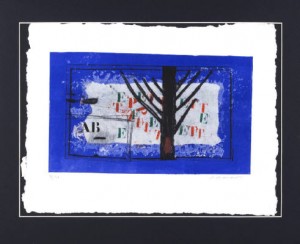“The painter is, like everybody, witness of his time…I focus in my paintings on the anguishes and agressions of mankind by my gesture of anger, dynamism and also of hope.” James Coignard 2002
James Coignard was born in Tours, France in 1925. At the age of three he moved to Paris with his parents. As a child he had an insatiable appetite for drawing and painting. In 1948, at 23 years of age, he made up his mind to become an artist and enrolled at the Ecole des arts Décoratifs in Nice. Hel ater apprenticed under the well-known painter Marchand des Raux. The following year the two of them staged a joint exhibition at the Musa de I’lle de France in St. Jean Cap Ferrat. Around the same time Coignard came into contact with the great Henri Matisse and was influenced by his work but soon began to seek his own ways forward. Not long afterwards, Coignard discovered the modernist™ handling of color via the techniques of Georges Braque and Marc Chagall. In both his mixed media on canvas and his works on paper, James Coignard is known for his technical versatility and use of vibrant primary colors. Coignard achieves a deep, heavy texture which is distinctive trait in his art.
With just a few strokes of his brush he conjures up an entire world. James Coignard extends the boundaries between concrete and abstract. He knows how to create chromatic melodies that shift in timbre from cobalt blue to blood red, from earthy tones to blocks of color as black as night. His paintings embrace everything from vast expanses of color to spaces enclosed. His pictures are an artistic epicenter where lines, letters and numbers mold with vigorous swashes of color. His paintings and graphic works are an artistic adventure, an aesthetic game in which the destructive and the momentous mingle freely with the spontaneous and the sensual.
He varies his subject matter endlessly in one painting the focal symbol might be a secret sign; in another, a sensually conceived female body. His themes might as easily be small squares that seem to describe an urban formation, cave paintings of animals that may well have been taken from Spain’s Altamira or France’s Lascaux, or a full-blooded scene from a brutal bullfight.
The paintings become magical. They trace an immense line over the heavens, a clean-cut brush stroke that transforms into a view of a mysterious and infinite universe. Paradoxically, Coignard casts the tangible and the unspeakable in the same mold, placing the luminous in opposition to the dull.
Several works from his early years reveal an unquenchable thirst for life, an indefatigable desire to paint whatever touches our innermost feelings and the landscapes that surround. Other works create a rather more melancholy mood against a somber backdrop. The facility for creating symmetrical lines that contrast with the chaotic and irrational has become a hallmark of Coignard’s work.
Many of his paintings present saturated colors as a contrast to the grey, almost extinguished and effaced. Life meets death.Such is his pictorial universe, spinning like a never-ending whirligig populated by humans, animals and phantasmagoria.
His contact in the late 1950s with a number of Spanish artists and his special fascination for Catalan sculptures and frescoes proved decisive for his artistic development. In the 1960’s he began to create sculptures in bronze and glass, which he has continued to produce parallel with his paintings and graphic work. In the late 1960s Coignard produced his first etchings in the gravure au carborundum technique. The carborundum process of printmaking was developed by Henri Goetz in the 1960’s. It was Goetz himself that taught Coignard and other artists the use of carborundum for printmaking.
Since his first solo exhibition in Paris in 1960, Coignard has exhibited in major galleries and museums throughout the world, and is well represented in both private and public collections that include the Guggenheim Museum in New York and the Museum of Modern Art in San Francisco, California. He is represented by the Paule Friedland & Alexandre Rivault Gallery in Paris and edited by the Pasnic print house in Paris.
Today he is based in the south of France, with a studio in Antibes and a home in the outskirts of Cannes.


[…] French artist born in 1925 whose paintings and etchings I admire is James Coignard. He dealt with extremely tactile surfaces and the use of some graffiti. The structure of his […]